ROOTS
SLOW AND STEADY WINS THE TASTE.
SPRING ISSUE
2024

Welcome to ROOTS, Local Food Lothian’s very own magazine. At Local Food Lothian, we believe that everyone everywhere has the right to the pleasure of food that is good for them, good for the planet, and good for the people who produce it. We bring together communities of consumers and producers to explore Scotland’s rich food culture. We’re inspired by Italy’s slow food movement that was concerned with defending biological and cultural diversity. We hope you enjoy our Spring issue of the Local Food Lothian magazine.
In this issue you’ll see us rave about our star vegetables (leeks, carrots, and the mighty asparagus) and highlight the amazing food-conscious community in Edinburgh and the surrounding area. You’ll get a tear-out calendar of seasonal veg and a map of the local businesses and initiatives that are a core part of our community.
In this issue we took a few deep dives (or digs!)… One is a spotlight on Scotland’s first rescued food shop, the SHRUB Coop; another is a peek into local produce in Lothian schools. You’ll also find some recipes that give you a starter and a side from our star vegetables. As always, near the end you’ll find our section for wee ones (and grown-ups, too!) filled with activities and puzzles.
We hope you enjoy hearing more from our partners across the local area discussing their various projects and initiatives. We’d love you to visit some of the sites in our map on pages 12-13 and tag Local Food Lothian in your snaps. Happy reading – and happy scranning!
Love, ROOTS
2 3 CALENDAR. 4,5 SHRUB COOP. 6,7 COMMUNITY APPEALS. 8 DIG IN. 9 VEG OF THE QUARTER. 10,11 LOTHIAN LOCALS MAP. 12,13 STARTERS AND SIDES. KIDS CORNER. 18,19 LOCAVORE. 21 ABOUT US. 24 SILVER SERVICE MEALS. 22,23 ECO-FRIENDLY EASTER. 20 14,15,16,17
CALENDAR
January



This calendar is a visual representation of some of the most popular seasonal fruits and vegetables. The sun is rising and the birds are chirping – Spring has finally come around, so take a closer look at months March - April.

May






March April 4 5










October




6 7
SHRUB COOP
22 Bread Street
Our Spring issue’s spotlight organisation is the wonderful SHRUB Coop, an Edinburgh-based Zero Waste Hub. This community-led cooperative is all about encouraging realistic low-carbon lifestyles. From their vegan cafe to their food sharing shop, SHRUB’s initiatives perfectly encapsulate the slow food movement.
The hub is also full of other enriching, environmentally sustainable projects such as their sewing cafe, clothing swap-shop, and bike repair workshop. So, get yourself to Bread Steet and show this local charity some love whilst practicing environmentally conscious living.
Keep reading to find out more about SHRUB and how its rescued food shop operates!
SHRUB was founded in 2008 by a group of students from the University of Edinburgh. It was originally created as a space for incoming students to take things that had been left behind by outgoing students, preventing a cycle of valuable materials being chucked away and rebought each year.
From there, SHRUB continued to grow and was established as a not-forprofit charity, registered officially in November 2018.
About 5 years ago, they set up a shop on Bread Street where they built their vegan cafe, food sharing hub, swap-shop, and social space for events like board games and yoga. It is now a thriving community hub with a warm, safe, and sustainable atmosphere that is open to all.
SHRUB COOP AIMS:
“Provide a welcoming space for rethinking our relationship to waste, reducing consumption, and developing effective use of resources.”
“Support community empowerment in Edinburgh, learning, and sharing skills to make a practical difference to the world we share.”
Saturday 11am-6pm Sunday
Tuesday –
11am-4pm
I took a trip to the SHRUB Coop to talk with Community Hub Coordinator Heloisa Fyfe about their food sharing initiative.
So, how does your food sharing hub work?
“Every evening, we work with Cargo Bike Movement who send volunteers out to all the neighbouring supermarkets. They collect all the surplus food at the end of the day that they haven’t sold, and then it comes to our volunteers who are here waiting to sort everything and make sure the food is safe and good to be eaten!”
How do you establish which food is safe?
“So, anything that has a use-by date of that night that can be frozen gets put in the freezer and then that extends its life by one month. Anything else like bread, pastries, fruit, and veg that is fine to eat after its best before date gets put on the shelves in our hub and then people can come in and take the food for free or for a donation. Anything that is going to expire that evening and cannot be frozen, for example premade sandwiches or salads, we send on to homeless hostels which are open all night.”
What kind of food do you find you receive the most?
“It varies throughout the year. It’s quite funny because every year we’ll just have one week where we get loads of bananas, then we’ll get avocados. We also have this thing where supermarkets start ordering festive themed
things way too early so Easter themed things will come to us in January because no one buys them that early. It becomes quite a fun challenge for the cooks in our cafe to incorporate the food.”
How much food do you usually receive?
“It is usually around 200 or 300 kilos every night. There is always food available and that’s the scary thing, there is so much over-production. It is good because we are able to redistribute it for free but really that waste shouldn’t be happening in the first place.”
It’s great that places like this exist to stop it from becoming waste...
“Yes, and what’s also good with these kinds of places is we can help people who are struggling to make ends meet but don’t fit the requirements of food banks, for example. They can come here and there’s no questions asked, you can just take the food.”
How close do you feel Scotland is to becoming zero waste, or do you think there is still a long way to go?
“I think that Edinburgh specifically is doing pretty well compared to other places, just because of organisations like these. A lot of it is about that knowledge of knowing that there is a hub here, there could definitely be more places like us dotted around Scotland.”
-By Bethany Lee
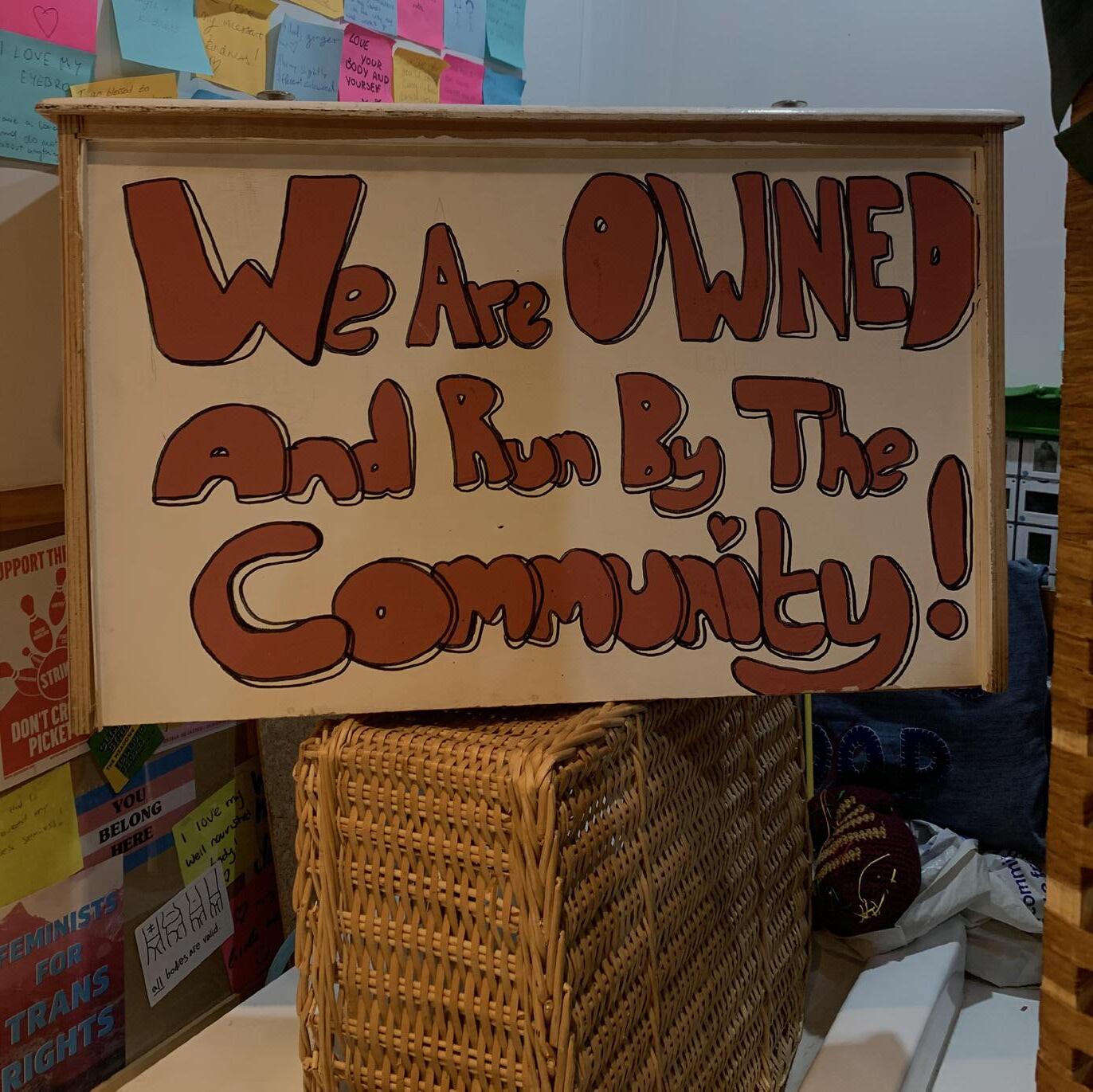
8 9
COMMUNITY APPEALS
VOLUNTEER WITH LOCAL FOOD LOTHIAN
Are you passionate about good produce, fair treatment of workers, and our local environment?
Then you could be a perfect fit for Local Food Lothian’s volunteer team!
From organising activities and events to running social media and our website, you could help spread our message.
Get in touch for more information.
LOCAL FOOD LOTHIAN RECIPE BOX COUPON
This coupon is redeemable against 25% off your first order of our very own recipe box, containing ingredients for this issue’s recipes!
Find the link on our website and use code ‘ROOTSSPRING24’ at checkout for money off your first box.
LOCAL FOOD LOTHIAN STALL COUPON
Come on down to our stall at the Grassmarket every Saturday from 10am.
You’ll find fresh, local produce from our amazing Lothian food community .
Show us this coupon and you’ll get buy one get one free on your whole order!
Happy shopping!
SPONSOR-A-HEN
Do you have a loved one who adores animals? Why not sponsor a local hen!
Sponsorship includes a welcome pack with photographs of your chosen hen, your very own adoption certificate and lots of fun facts about chickens! You’ll get seasonal updates, too. For as little as £3 a month or £36 a year, you can help us look after our chickens in their retirement.
Love, the Old Bird Retirement Home
VOLUNTEER FARM HAND
Family farm in East Lothian is looking for assistance in lambing season to help us deliver happy and healthy lambs.
Must have experience working with animals. Availability weekday mornings.
Give us a call at 07xxxxxxxxx for more information.
PUPPIES SEEKING WALKER
We‘re three golden labs looking for someone as energetic and excitable as us to walk us on Mondays and Fridays.
Based in Tollcross, close to the Bruntsfield Links (our favourite spot!)
£15 an hour
Give our owners and email at: walkourpuppies@family.com
Dig In Bruntsfield: Your friendly neighbourhood greengrocer
In the heart of Edinburgh, a unique community grocer calls Bruntsfield its home. Welcome to Dig In Bruntsfield, where a love for locally sourced produce comes together with the spirit of community.
.
Embracing local, savouring quality
At Dig In Bruntsfield, the commitment to supporting local farmers and producers is at the core of everything they do. The shelves are stacked with a vibrant array of fruits, vegetables, dairy, and more, all sourced from the rich Scottish landscapes. Beyond the fresh produce, Dig In Bruntsfield offers a varied selection of local delicacies that showcase the best of Scottish cuisine. Indulge in artisanal cheeses, handcrafted chocolates, and a curated collection of beverages that celebrate the region’s rich culinary heritage. Each item tells a story, and every bite is a journey through the flavours of Lothian.
Your eco-friendly shopping destination
Dig In Bruntsfield takes its commitment to sustainability seriously. From reducing single-use plastics to supporting eco-friendly packaging, every effort is made to minimise the store’s environmental footprint. Shopping at
Dig In Bruntsfield isn’t just about nourishing yourself but also about contributing to a healthier planet.
More than a grocer – a community hub
Dig In Bruntsfield is not just a place to pick up your groceries; it’s a community hub that brings people together. The knowledgeable staff are always ready with a smile, offering advice on the best produce or helping you discover something new. The warm and inviting atmosphere encourages neighbours to linger, share stories, and connect.
In a world where convenience often trumps connection, Dig In Bruntsfield stands as a testament to the beauty of community and the richness of local flavours. Step into this culinary haven, where every visit is an opportunity to discover, connect, and savour the best that Edinburgh has to offer. Dig in and experience the joy of community-driven, fresh, flavourful living at Dig In Bruntsfield.
This is an advertorial.

10 11

ASPARAGUS
THE USAIN BOLT OF VEGETABLES
The Spring season brings a plethora of fresh vegetables to incorporate into your slow food recipes. For our vegetable of the quarter, we’re bringing you facts and figures all about ASPARAGUS!
Asparagus is native to Eurasia, but in the UK there is a thriving asparagus industry. The British climate is perfect for asparagus to flourish with its sweet flavour and tender texture. Asparagus is in perfect season for 8 weeks from the 23rd of April to the 21st of June.
Asparagus is low in calories, and high in vitamins, folate, minerals, and antioxidants. It can be cooked by boiling, grilling, steaming, roasting, and sauteing and used in soups, stews, and salads.
FUN FACTS
FUN FACTS
Asparagus...
• can grow up to 10cm in one day!
• is 94% water!
• provides 6% of your daily potassium requirements!
• is one of the 15 cleanest vegetables (of pesticides)!
• was referred to as “sparrow grass” in the 17th Century!
• helps form red blood cells and produce DNA for healthy growth and development!
• is a good source of folate. 90g of asparagus provides pregnant women with 22% of their daily folate needs!
TRUE OR FALSE?
TRUE OR FALSE?
Asparagus can cure hangovers? .... we don’t know. Many have claimed that eating asparagus before drinking will improve your morning blues. However, this is not backed up by a lot of research – so feel free to explore it!
Asparagus makes your urine smell? .... yes, sometimes. Asparagus can make your urine smell – but not for everyone (scientists still don’t know why it curses some but not others!)
Eating asparagus whilst pregnant increases your chances of having a boy? ....no, but people genuinely used to believe this was true!
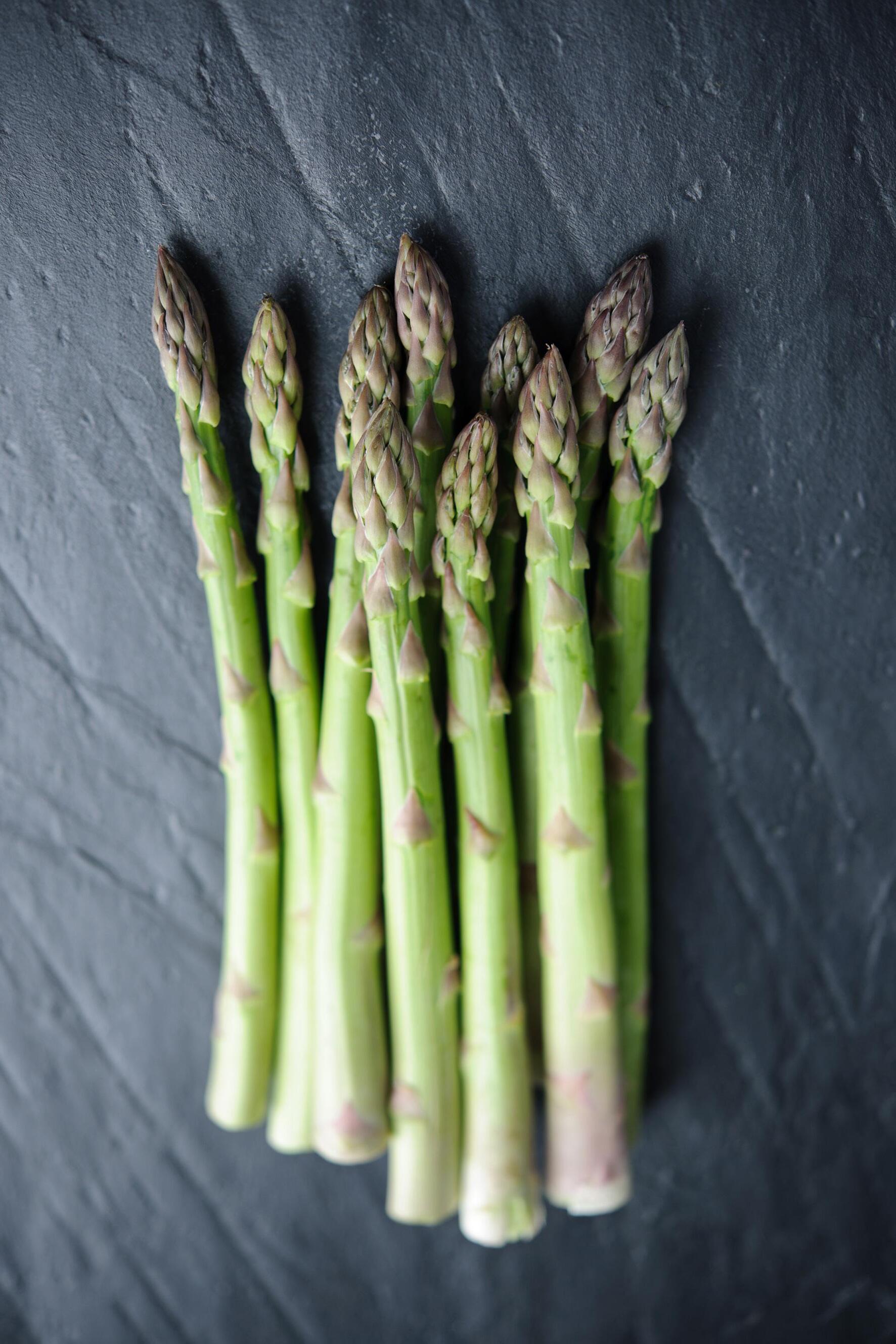
12 13
LOTHIAN LOCALS









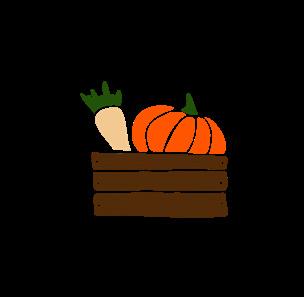










Leith Farmers Market Portobello Market Edinburgh Farmers Market Stockbridge Market Mossgiel Farm Milk Stockist: Margiotta Mossgiel Farm Milk Stockist: the Refillery The Refillery 181 Delicatessen Weigh to go The Good Store Roman Pizza Project I. J. Mellis 3 17 18 21 23 24 MAP 22 3 5 6 7 8 10 11 13 15 16 19 20 1 2 4 5 6 7 8 9 10 11 12

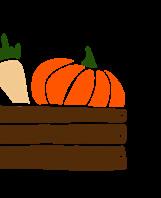


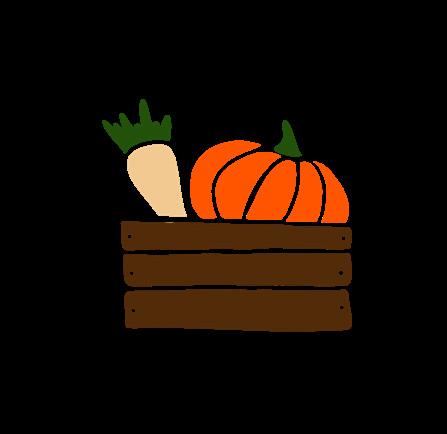





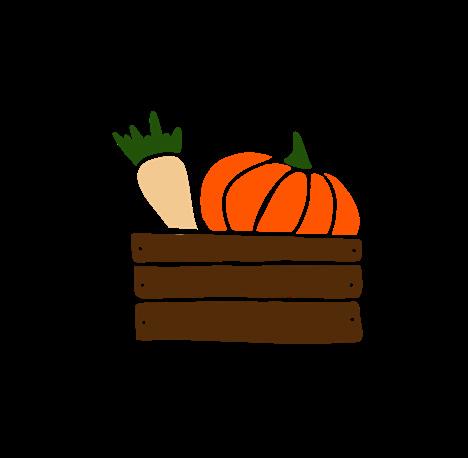
Twelve Triangles Bakery Andante Alex bakes by Breadshare Greybe Fine Olive Products The Source Coffee Roasters Scotland the Bread Stockist: Good Food Allan Campbell Butchers Saundersons Quality Butchers Bacco Wine Cork & Cask Welch Fishmonger Armstrong’s of Stockbridge 17 14 15 MAP 22 17 18 21 22 23 24 15 20 2 1 4 9 12 14 13 14 15 16 19 20
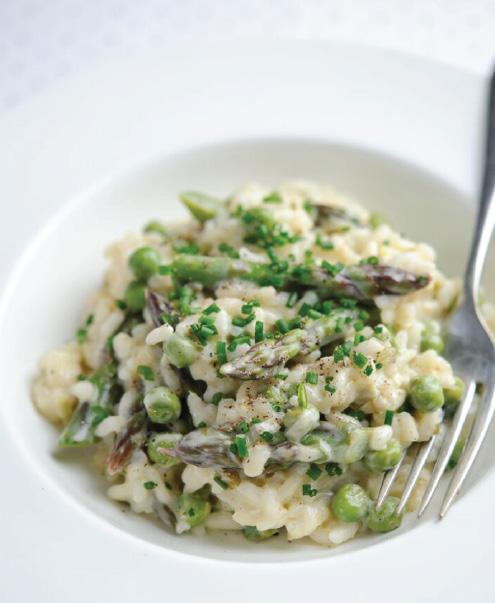
300ml veg stock
75g arborio rice
50g peas
¼ asparagus
¼ glass white wine
2 spring onions
1 garlic clove
¼ chilli
3 tbsp lemon juice
1½ tbsp crème fraiche
1 tbsp grated cheese
Photograph credit: britishasparagus.com

STARTERS AND SIDES
Asparagus and Pea Risotto
Make up 300ml veg stock and keep on low heat as you cook.
Finely chop 2 spring onions, de-seed and finely chop ¼ chilli (or use chilli flakes), and crush and chop 1 garlic clove.
Melt butter in a separate pan and soften the spring onions, garlic, and chilli. Add 75g arborio rice (adjustable) and mix to absorb flavours and cover in butter, then pour in ¼ glass white wine.
Once the wine is absorbed, add ¼ bundle asparagus and add stock ladle by ladle as it soaks in, stirring constantly.
As the rice nears completion, adjust
taste with seasonings (salt and pepper, herbs, and additional stock concentrate) and add 50g peas. When all liquid is absorbed and the rice has become ‘creamy’, add lemon juice to taste, 1½ tbsp crème fraiche, and 1 tbsp grated hard cheese. Serve topped with herbs (finely chopped parsley or chives).
Vegan adjustment: Check your wine is vegan, use a vegan spread rather than butter, and skip the dairy products or use vegan versions.
Conscious carnivore: Use chicken stock and add cooked chicken with the peas and seasoning.
16 17
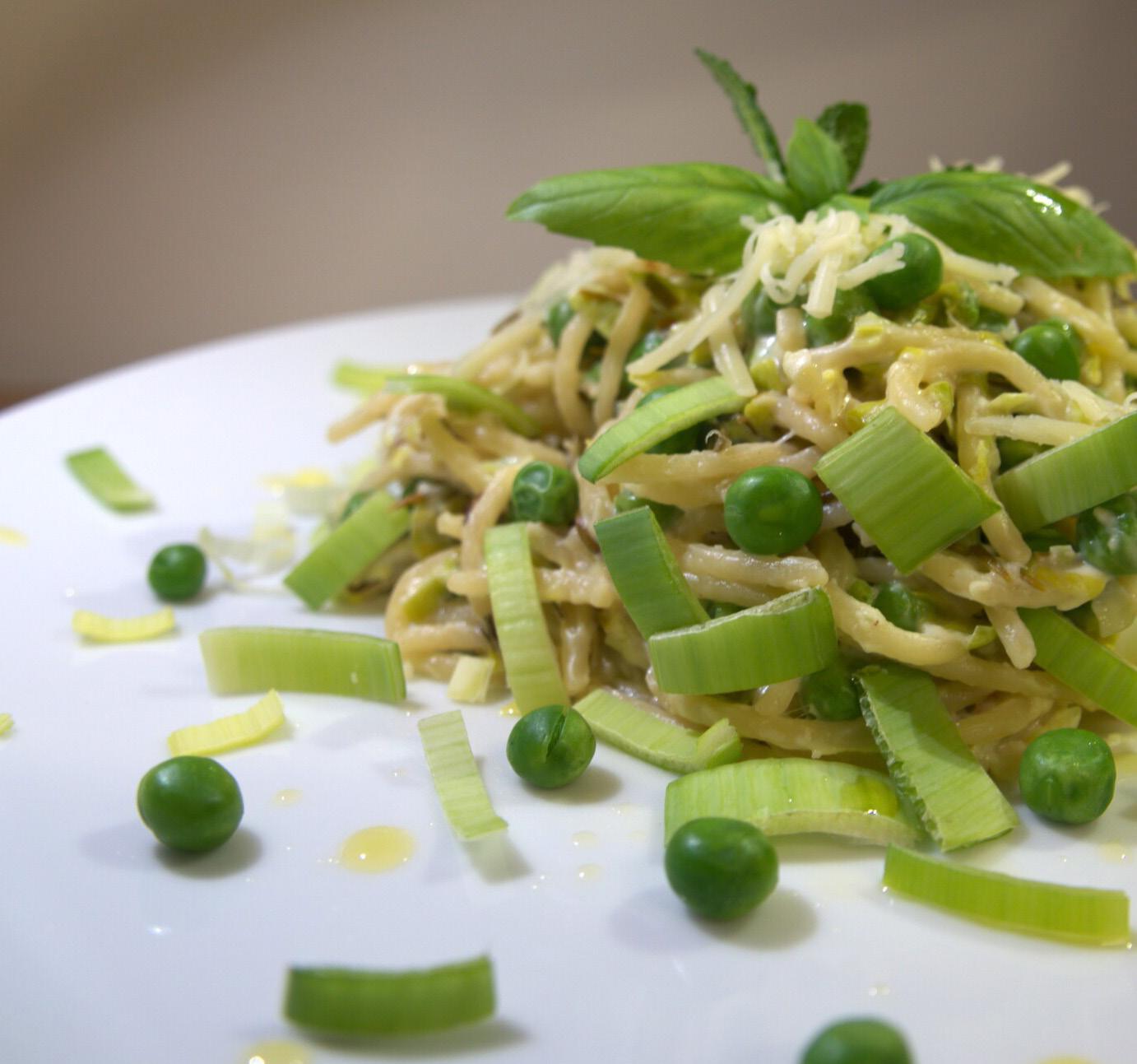
Leeky long pasta
Quarter ¼ leek lengthwise and thinly slice. Crush 1 small garlic clove
Cook 1 serving linguine/ spaghetti/tagliatelle with 1 sprig (or 1 tsp dried) thyme for 5mins, then add leeks and garlic. Simmer for 5mins.
Add 50g peas (frozen is easiest) and cook until pasta is al dente. Drain, and remove thyme sprigs. Stir in 80ml single cream and grate in 20g cheese.
Serve hot, garnished with freshly ground pepper and chopped flat-leaf parsley
Vegan adjustment: Swap out the creamy cheese sauce for a thick cashew cream with nutritional yeast or your favourite vegan cheese. Or reserve some of the pasta water and stir in a cheese alternative to thicken into a sauce.
Conscious carnivore: Add bacon. Smoked works better for stronger flavour.
Serving linguine/ spaghetti/tagliatelle
80ml single cream
50g peas
20g cheese
5g flat-leaf parsley
1 leek
1/2 onion or 1 shallot
2 small carrots
10g coriander leaves
10g mint leaves
50g natural yoghurt
1 tsp lime pickle
1/2 tsp ground turmeric
1/2 tsp cumin seeds
50g gram flour
Carrot and coriander pakoras
Finely slice ½ onion/1 shallot. Grate 2 small carrots lengthwise into thicker strips. Snip up 10g coriander leaves and mint leaves (separately).
Toss the carrots and shallots with ½ tsp sea salt in a colander (placed either in the sink or over a tea towel to allow draining) and leave until wilted (10mins or so).
Mix 50g natural yoghurt, 1 tsp lime pickle, and mint leaves into a sauce, and set aside in the fridge.
Once the veg wilts, squeeze out extra moisture in a tea towel and tip into a bowl with snipped coriander, ½ tsp ground turmeric, ½ tsp cumin seeds, and mix. Add 50g gram flour and water, and stir until all is coated
into a thick, even batter (very important).
Fill a large pan to two-thirds with oil, and heat to 180°C (or until a bread cube browns in it in 20 seconds). Carefully lower in 2tbsp of mix at a time, spacing them apart, and fry on each side until golden and crisp (12mins).
Once done, remove with a slotted spoon and place on kitchen roll to allow draining. Serve hot with dip.
Vegan adjustment: Skip the yoghurt dipping sauce and go for pickle alone, or swap in a plain vegan yoghurt.
Conscious carnivore: Serve with lamb samosa to bring some springtime to your snacks.
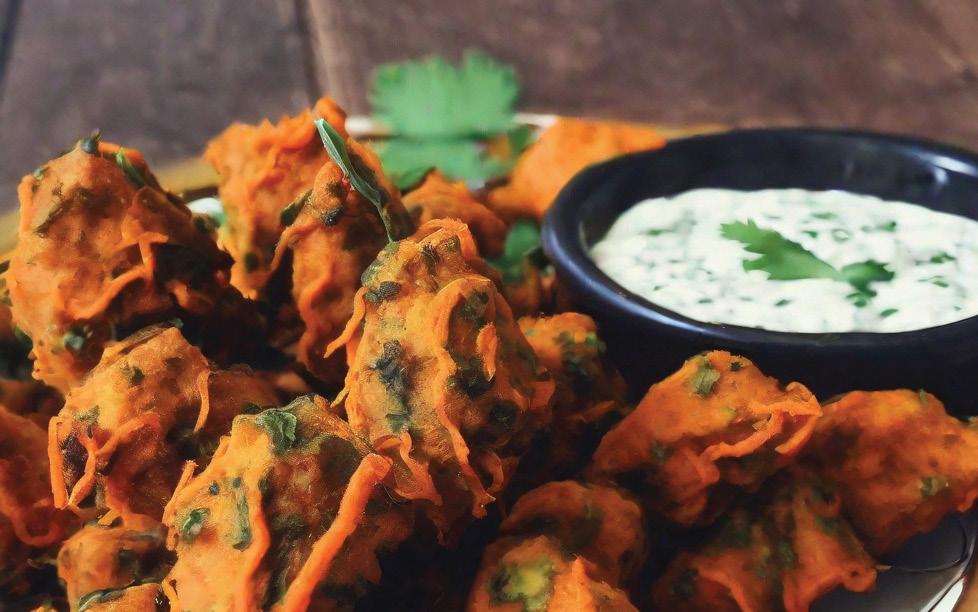
18 19
Spring Crossword
Spring Crossword
[3] Vegetable that comes in 'spears'
[6] Root vegetable
[7] Colour or type of vegetable the first day of May Down
[1] Yellow flower
[2] Baby animal you see in Spring
[4] Outdoor activity that is perfect for the spring
[5] Vegetable whose name
[8] Mussels, trout, scallops and haddock are all types of
Basil is a great starting point for or addition to your kitchen garden. Follow these simple instructions to grow the seeds included in the magazine. Basil isn’t a very tough plant, so it’s best to sow it inside and only plant it outside after the last frost. This year, the last frost in Edinburgh is 1-10 May, so we suggest planting the seeds from the beginning of March.
What you need:
•
•
•
•
• Super seeds: How to grow basil
Seed trays, old egg cartons, or make your own pots out of newspaper!
Soil
Clear plastic bag or cover
Plant pots
Water
Method:
1. Fill your seed trays or pots with soil, and place 2 to 3 seeds in each pot, covering them with soil.
2. Cover the seeds with a plastic bag or other clear cover and keep them warm. Check the soil every day, and water it when it’s dry - too much water is bad for the basil.
3. Once the seedlings start to grow, after 5 to 7 days, uncover them and place them in a sunny spot like a window sill.
4. When the seedlings grow leaves, move them into their own pots.
5. After 6 to 8 weeks, when the basil has grown stronger and the weather is warmer, plant the basil outside.
Choose a sheltered area or a greenhouse. It’s best to grow basil in pots - yopu can plant one plant per pot or place a few of them in a large pot.
6. Keep basil warm, and water it regularly.
7. If you plant basil in the spring, it should be ready to harvest in summer. You can use your homegrown basil in lots of tasty recipes!
Across
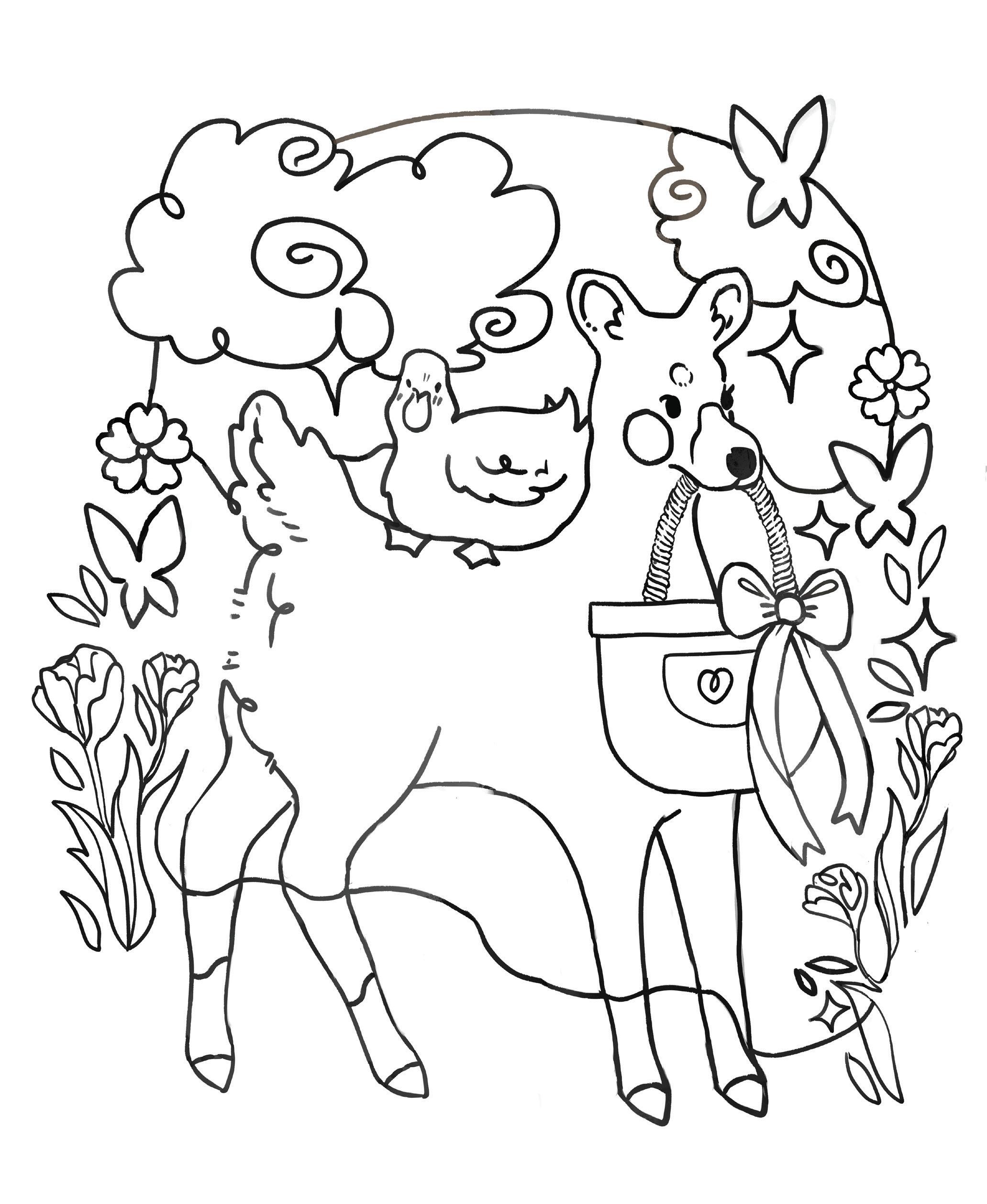
20 21 Colour
in!
me
Eco-friendly Easter
Spring is a season of growth, making it a great time to take action for the environment. Here are some tips to enjoy an eco-friendlier Easter.
1. Avoid plastic eggs and packaging
You can make your own out of recycled materials like paper mâché. Or swap eggs for tasty treats you can make such as chocolate cornflake nests.
3. Buy organic and fairtrade chocolate eggs
Did you know that the packaging of a typical Easter egg makes up one quarter of it’s weight? All that plastic and cardboard ends up as waste.
Luckily, you can find a wide range of vegan, eco-friendly or Fairtrade eggs that are just as tasty and much better for the planet and the people who make the chocolate. There are some great places in Edinburgh who make treats for Easter.
2. Make an Easter basket out of recycled materials
Instead of using a plastic basket for your egg hunt, try making your own with upcycled paper, plastic or fabric.
4. Eggcellent Eco-friendly activities
Why not use Easter as an opportunity to connect with nature and learn new things? Visit a farm and meet baby animals, go on a nature walk or take part in a Local Food Lothian Learning activity. With Local Food Lothian Learning, use all your senses, while trying fun new foods and learning where it comes from.

Eco-friendly egg decorating
Instead of using artificial dyes, try making your own out of simple ingredients you can find in your kitchen. You can create almost any colour you want by using different vegetables. Here are some ideas or try experimenting your own!
Lavender: Red onion skin
Yellow: Turmeric Pink: Beetroot
1. Add your chosen dye material to a saucepan of water, and bring it to a boil (ask an adult for help with this). Cover, and let it simmer over a low heat for half an hour until you get the colour you want.
2. Let the dye cool, strain it into a jar, and mix vinegar into the dye.
3. Add boiled eggs, then put them in the fridge.
4. Remove the eggs when you get the desired colour, then dry them and rub some oil on them to make them shiny.
Buy organic eggs to help the environment and local farmers. You can find ethically sourced eggs at many of the producers, farmers and retailers on our list. When you’re done with your dyed eggs, don’t forget to compost your eggshells!
LOCAVORE
Accessibility and affordability – roadblocks to clean living?
Fear not, there are local options out there if you know where to find them. Enter –Locavore, an organic grocery store whose goal is for the everyman to feel free to bypass the supermarket and purchase great products at fair and affordable prices. Slow and sustainable food should be a goal for everyone, so everyone deserves the opportunity to explore and experience it for themselves, and Locavore is just one player in a larger movement to turn this planet around and make the most of what we have.
Embracing
the natural,
.
A space for good ideas
Looking for a place to rent as a site for your own local business? Locavore has you covered. They have several extra spaces across their locations available for rent at below standard commercial rates – this side initiative was born from a desire to bring people together, building a sense of community around shared goals.
Sharing in seasons of growth
With wedding season on the horizon, Locavore is keeping costs down for their customers, so they offer 60-80 stems of wildflowers for only £55, which for events on a smaller scale is such a steal, so you can participate in a sustainable save, supporting a local business at the same time. There is also a chance to learn all about growing flowers and putting together arrangements in one of their workshops, which run on the first Friday of each month and include a meal from the Locavore kitchen. So, join the movement and start shopping local today.
right around the corner
Sourced from farms located in Glasgow and Linlithgow, all three of which are no more than 15 miles from one of their shops, Locavore’s produce offering is not limited to the classic fruit & veg, cheese & dairy, and fresh & frozen meat, but also extends to eco-friendly household cleaners, fresh bread, and flowers. Visit one of the four shops – Edinburgh, Kirkintilloch, Glasgow Govanhill, or Partick – making sure to bring your own bags, jars, and boxes in alliance with the organisation’s mission to remain sustainable, cutting down on waste.

22 23
This is an advertorial.

Silver service meals in East Lothian schools
On a below-zero January morning, I headed down to the banks of the Firth o’ Forth to bonnie Musselburgh. And no, it wasn’t for a late Loony Dook, but more of an eager look… into what Campie Primary was plating up for lunch.
“Oh, you’re here for haggis, neeps and tatties day today,” the school’s cook supervisor, Ashley Kilpatrick, disclosed with a smile as she cut open several packets of Campbells Prime Meat haggis made from Scottish lamb. “We’ll have well over a hundred for the meat dish: popular with the kids,” she added, as she placed the trays into the steamer for a long cook prior to a quick final oven job. “Everybody likes crisped-up haggis.” I nodded in agreement, beginning to feel peckish . Ashley placed the peeled tatties, supplied by George Anderson fruit and veg from just down the road, into another steamer.
Campie’s cook supervisor has become a bit of a local hero of late, and not just for understanding the finesse of haggis preparation for all ages. After completing a professional cookery and catering course at Edinburgh College, she joined Portobello High’s kitchen team before moving to Musselburgh in 2019. Last year, her line manager asked her to become an ambassador for Food for Life Served Here (FFLSH), which East Lothian had been
running since 2013. Ashley, who returned a positive “aye, I think I can do that” to her manager admitted finding it a bit daunting at first. “It was a new role and programme – but we met other ambassadors online from across the country and bounced ideas off one another.”
The role of ambassador was established for a programme supported by the Scottish government and in cooperation with Soil Association Scotland, backing sustainable food and farming. FFLSH works with schools to change not necessarily the way food is cooked, but where it is sourced for the process from produce to plate, while still ensuring balanced nutritional choices and more organic produce. Through their central catering teams, East Lothian schools are sourcing more locally, reducing food miles while also improving quality.
But it’s not only about what goes in the oven. “We also decided to develop a grow garden with the support of the teaching team. The kids planted and grew fresh vegetables and herbs, which were then made into vegetable soup at
Food for Life ambassador: Ashley Kilpatrick
lunchtime,” Ashley added while checking the organic yoghurt count in the fridge.
Nurturing learning. The efforts saw ambassador Ashley, and others involved in the project, win the silver award status for East Lothian for the second time. “We were pretty chuffed,” Ashley smiled, modestly brushing off the achievement, reaching for the neeps.
“Food is connected to our health, the environment, and the local economy.”
The Soil Association began the initiative in 2003. Funded by the Scottish government since 2012, it has since been rolled out to 17 of Scotland’s 32 local authorities. To attain bronze status, schools must comply with nutritional guidelines with 75% of their food freshly prepared from unprocessed ingredients, among other goals. For silver or gold, more produce must be sourced locally, and with either 5% or 15% organic produce for silver and gold respectively.
With only two local authorities in Scotland making silver, Soil Association Scotland Food for Life’s partnership manager, Sarah Gowanlock, explained how the East Lothian achievement was really quite the accolade. “It’s really exciting because East Lothian has always had great food but it was a reason for us to celebrate where they were going above and beyond,” she said. One of the success stories was switching to Mungoswell Malt & Milling – organic flour from East Lothian.
But sometimes, there’s the age-old challenge of getting children to eat their
greens! “Unfortunately, the naughtier stuff on the menu is really popular! Pizza day is always a hit,” Ashley admitted. But she has noticed a positive change in what the pupils were choosing. “Our fresh salad bar is very popular – it’s also about us encouraging them, making it look nice so they want to take it.”
With councils also feeling the pinch of the cost-of-living crisis, sticking to local and organic produce can be testing. “We know this is a very challenging time but it’s really about value for money, not just about cost,” Sarah explained. “Food is connected to so many things: our health, our environment, our local economy.”
It was now 9am and the other members of Ashley’s team were readying themselves for the nursery due in for a meal fit for a Burns supper at 11:30am. I told kitchen help, Karen, I was here to interview ‘ambassador Ashley’. “Oh, she’ll be known as that from now on,” she joked, offering her a courtesy.
Ashley returned to the sink, slightly redfaced. I asked her whether she enjoyed cooking at home: “My partner does most of it because after being here all day, I’m like – ‘no thank you’”. I just hope they know how to crisp up the haggis.
-By Jamie Smith

24 25
About Local Food Lothian
ROOTS is our ‘thank you’ to you for being part of our work to cultivate a sustainable food culture in the Lothian area. Published quarterly, with each issue an ode to its season, this magazine is dedicated to Edinburgh’s food community. This Spring issue we’ve met the awardwinning ambassador in Musselburgh cooking up a locally sourced storm in primary schools, witnessed the amazing initiative over at SHRUB Coop, and learnt more than we ever thought possible about asparagus. We’ve planted herbs and dyed Easter eggs, been introduced to some exciting places around Edinburgh who champion our values, and – most importantly – cooked some delicious recipes.
Local Food Lothian began in 2006 after a group of foodies started to become more concerned about where their food was coming from. This slowly developed into a community across Edinburgh and the Lothian area that values consumers and producers equally. Local Food Lothian believes in Scotland’s rich and dynamic food culture. With an emphasis on local businesses and local communities, Local Food Lothian believes that everyone can and should get fresh, great quality scran.
Your support helps us spread our message about food that is sustainable, ethical, and delicious in our local communities and across the world. To help us on our mission and get involved with the Local Food Lothian, why not volunteer with us? Get in touch with us at info@ localfoodlothian.com. Find us on LinkedIn at ROOTS Magazine.
Thanks for reading, Love, the ROOTS team.

26 27
Project Manager - Alex Orr
Editors and Writers - Sammy Langley, Simone Meadows and Shan Heyworth
Journalists and Writers - Bethany Lee and Jamie Smith
Designers - Caroline von Gregory, Ethan Law and Ola Kazanowska
Advertising and Branding - Maddie Clayton
SPRING ISSUE 2024



































































